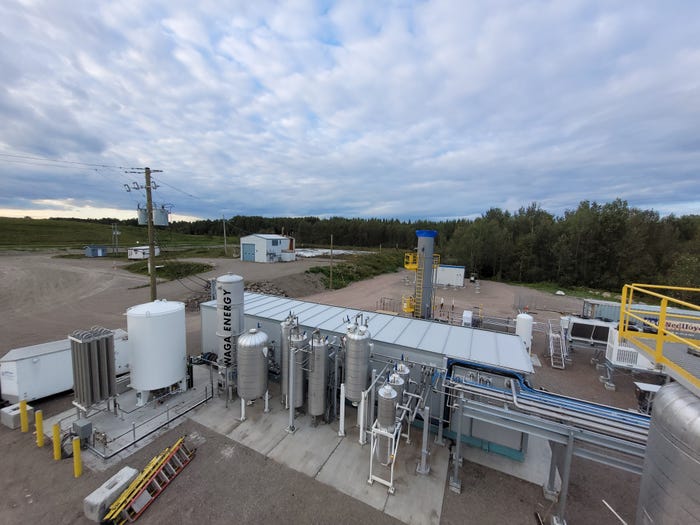Waga Advances RNG Projects in North America
In Chicoutimi, Quebec, Waga is making RNG from methane on a closed landfill, selling the clean renewable product to utility Énergir, and sharing revenue with the shuttered facility’s owner, Matrec-GFL. Quebec is requiring utilities to inject 10 percent RNG into the pipeline by 2030, and Waga sees landfills as playing a role in meeting that target while lowering facilities’ carbon footprint.

With 19 renewable natural gas (RNG) projects operating around the world, French-based RNG project developer Waga Energy has inked deals to build 16 more of them, with the next to launch in Indiana, New York State, and Quebec. Collectively all agreements will bring the company closer to its goal of a 13 million MMBtu (4 TWh) per year production capacity of RNG by 2030.
The interest in North America is spurred largely by incentives and rules that have opened opportunities there, but there’s more driving the business strategy.
“As the company grew it became evident we had technology that could have major impact on greenhouse gas emissions, especially methane. And when you look at the size of the landfill market there are 2,700 municipal solid waste landfills in the U.S. alone, so there’s opportunity to have big impact both through methane reductions and by displacing fossil fuel,” says Tanguy Largeau, vice president at Waga Energy.
In the U.S. the RNG is sold to the transportation market under the Renewable Fuel Standard (RFS) where WAGA generates credits (RINS) and sells them to refiners, fossil fuel importers, and other parties obligated to purchase RINS to comply with environmental regulations. But the company is seeing a lot of interest from utilities too, beginning in Washington State and Oregon, with more states starting to think of adopting RNG to achieve decarbonization goals.
The Indiana agreement is with Decatur Hills Landfill to build and operate a facility to produce pipeline quality gas, which will be injected into the local grid. The operation will process up to 1,000 standard cubic feet per minute (SCFM) of landfill gas while avoiding over 13,700 tons of CO2 equivalent annually, equal to cutting emissions from 1.4 million gallons of gasoline per year.
Waga is now entering the engineering phase and developing the gas interconnection agreement with plans to commission the facility and begin injecting RNG into the pipeline by December 2025.
“Decatur Hills is part of a larger family of companies, and as a group we have experience in different approaches to producing RNG from landfill gas,” says Curt Publow, environmental compliance manager, Decatur Hills Landfill.
One of the Indiana team’s first concerns, born from an early discovery, is around managing the gas’ nitrogen content.
“This is often one of the bigger challenges [in the gas treatment process], and we believe that Waga brings some unique solutions to that challenge,” Publow says.
Most existing technologies are limited in the nitrogen and oxygen landfill gas content they can accept, explains Largeau. And as operators work to reduce emissions and capture more gas, they increase the vacuum on the gas collection system, resulting in intrusion of oxygen and nitrogen.
“But our system is able to accept, then, remove up to 30 percent air gases, and still achieve pipeline-quality renewable natural gas,” he says.
The treatment is a two-step process, explains Julie Flynn, CEO of the Waga Energy Canadian subsidiary.
The raw gas is first filtered to extract the carbon dioxide and impurities. Then, it is distilled at a cryogenic temperature to isolate the methane from the nitrogen and the oxygen.
Waga touts its system as being able to produce and purify RNG, regardless of variations in gas composition, including nitrogen concentration. With this ability, operators can even install wells in operating cells, where there is high production of methane and hard-to-treat nitrogen, enabling better control of emissions and odors.
In Chicoutimi, Quebec, Waga is making RNG from methane on a closed landfill, selling the clean renewable product to utility Énergir, and sharing revenue with the shuttered facility’s owner, Matrec-GFL. Quebec is requiring utilities to inject 10 percent RNG into the pipeline by 2030, and Waga sees landfills as playing a role in meeting that target while lowering facilities’ carbon footprint; landfills generate about 28 percent of Canada’s total methane emissions.
Matrec-GFL declined Waste360’s interview request, but Waga shared a few details made public of the project, which was first commissioned in December 2023.
While gas production drops on closed landfills, the decline takes time. Studies show the Chicoutimi, Quebec landfill will generate on average 16 GWh of RNG per year over the course of the 10-year contract. That’s about how much gas 1,000 of the region’s households would consume, and enough renewable product to avoid more than 2,500 tons of CO2 equivalent, Waga says.

The company sees its technology as having potential for broad-scale adoption.
“WAGABOX is a plug and play system that we can install on any landfill with a nearby grid. And once we install the WAGABOX, it goes fast. We just have to connect the piping and the electrical power,” Flynn says.
Among the new North American facilities closest to commissioning dates are the New York State plant, which will be the first to launch in the U.S. Now entering the final stage of construction in Steuben County, it is slated to come online in 2024, with a capacity of 1,000 SCFM of natural gas
The next plant coming to Quebec is a 750-SCFM facility, which should begin operations in May 2024, with a 2,000-SCFM Vancouver Island operation on its heals, which should launch at the end of 2024.
About the Author
You May Also Like




.png?width=300&auto=webp&quality=80&disable=upscale)